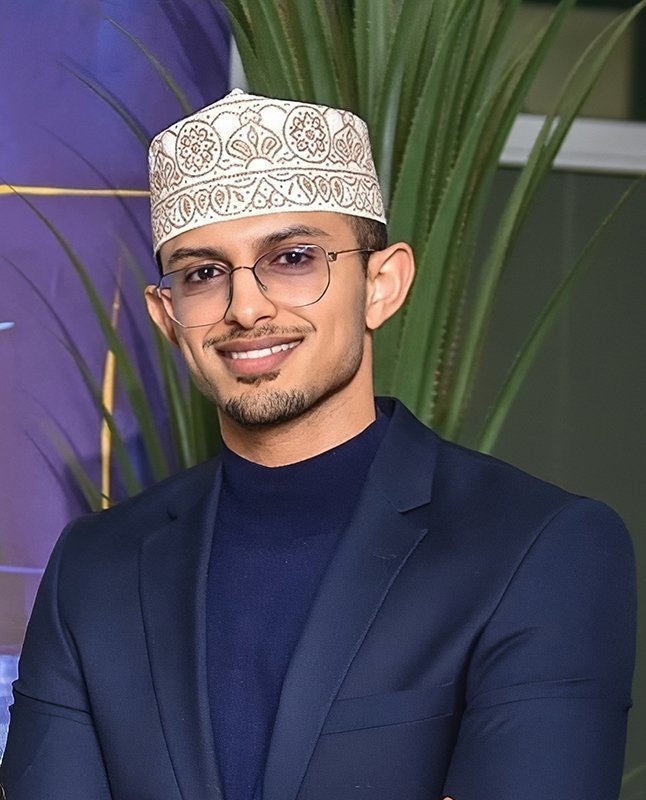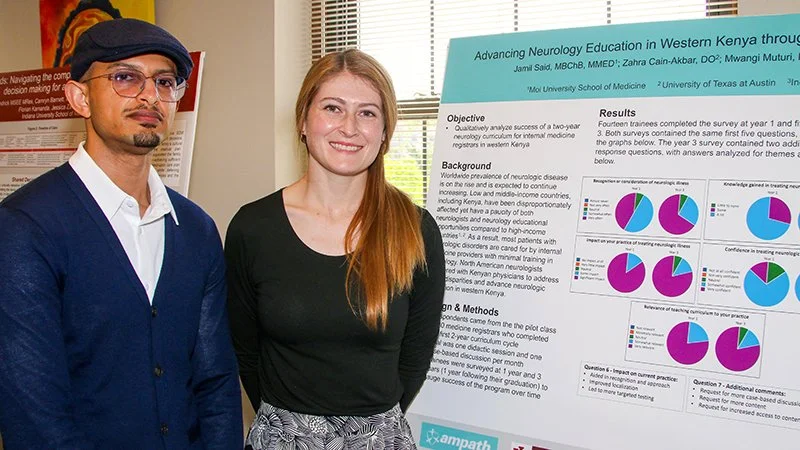Building Neurology Care: Dr. Jamil Said's AMPATH Journey
When Jamil Said first opened a neuroanatomy textbook as a young medical student, he had no idea the path it would set him on. “I just fell in love with neuroanatomy,” he recalls. “In fact, I thought that I might end up doing neurosurgery.”
Dr. Jamil Said
That passion, sparked in his second year of medical school, would eventually drive him to a career in neurology—one that now intersects deeply with AMPATH, the long-standing partnership between Moi University, Moi Teaching and Referral Hospital (MTRH) and a consortium of universities around the world working to strengthen health care in Kenya. His journey has been one of persistence, sacrifice, and an ambitious vision: to build neurology services for people that need them.
Falling for the Brain
In medical school, he not only studied neuroanatomy but volunteered to teach it to younger students. “I continued doing that across my undergraduate years until I graduated—and that was just purely out of passion,” he says.
But as his training progressed, surgery lost its appeal. “Surgery was too mechanical for me. I just liked what I call the ‘Sherlock Holmes’ moments of solving the mysteries in neurology and internal medicine.” By the time he graduated, neurology had become his true calling.
An AMPATH Opening
The entry point to the AMPATH partnership came unexpectedly. A colleague invited him to join the Population Health program. “I told him I had no idea how to handle this,” he admits. “He said, ‘Don’t worry. There’s a big team that’s going to guide you.’”
He soon found himself helping oversee AMPATH’s diagnostic truck project, which brought mobile testing services to rural communities. He then went on to co-lead the health systems strengthening arm of the AMPATH Population Health program, overseeing integration models that linked noncommunicable disease care with infectious disease services across western Kenya. This work not only expanded care for conditions like hypertension and diabetes but also created space to begin addressing neurological conditions such as epilepsy within the same integrated system.
The experience, he says, was transformative. “It provided a platform for experiential learning, which honestly in hindsight is the best sort of learning,” he reflects. “You gain experiences you wouldn’t read in a book.”
When COVID-19 struck, he served on the MTRH task force, helping craft strategies for the hospital. He also took on research roles, from cardiovascular-metabolic disease studies to implementation science. “I wore many hats while still working as a physician and an internist,” he laughs.
Chasing the Dream of Neurology
Despite his growing responsibilities, neurology remained his passion.
He was twice rejected from overseas neurology programs—simply because there was no neurologist in Kenya to write him a recommendation. “That was really challenging,” he admits. “But the message is persistence pays. I never gave up.”
When Aga Khan University announced the first neurology training program in East Africa, he applied. “Adrian Gardner [my longtime mentor] told me, ‘As long as it’s a good training program, go for it—it’s your passion.’”
Acceptance came with enormous personal cost. Training required relocating to Nairobi, with no salary and steep tuition fees. “It was a very tough decision,” he says. “I was thinking of my responsibilities as a father, as a husband.”
“But those were the happiest moments of my life. Imagine working 100 hours a week, no pay, and you still have assignments—but you end the week with this deep fulfillment,” he reflected.
Training Abroad
This year, fellowship training brought him to Indianapolis, where he spent nine months at Indiana University School of Medicine. There, he immersed himself in neurophysiology—EEGs, EMGs, epilepsy, neuromuscular neurology—while also forging collaborations.
“I developed networks with leaders in these areas,” he says. “They’re even giving me guidance on how to develop registries in Kenya robust enough to support cutting edge neuromuscular research in the continent and mentoring me towards becoming a leader in this space.” These connections could help link MTRH and Moi University with the U.S. National Institute of Neurological Disorders and Stroke (NINDS), opening doors for advanced research in neuromuscular diseases.
Dr. Said was especially appreciative of the support and mentorship provided by neurology leaders at IU School of Medicine including Laurie Gutmann, MD, chair of the Department of Neurology and co-director of the Neurosciences Institute as IU Health and IU School of Medicine; Robin Conwit, MD, professor of neurology and vice-chair of faculty development; and Robert Pascuzzi, MD, professor emeritus of neurology.
Outside the clinic, he found comfort in unexpected places—like Indianapolis’ Tinker Coffee. “It’s a bad habit I’ve developed, but they’ve got really good coffee,” he jokes. “We’d even discuss fermentation processes. It was a whole science!”
A Vision for Kenya
His plans are bold for his return to Eldoret. “My hope is to establish an adult neurophysiology lab at MTRH that will offer care, education and research—and be a hub for Kenya,” he explains.
If successful, it would be the first of its kind in the region and in a public setting.
The focus will be threefold: neurophysiology (especially epilepsy and neuromuscular disease), neuroimmunology, and stroke. To build capacity, he envisions recruiting physicians with interest in neurology, training them alongside him, and eventually sending them abroad for specialty training before they return as experts.
His vision goes further: to eventually launch Kenya’s first adult neurology fellowship training program outside Nairobi.
“Cardiologists at MTRH did it—they built a fellowship program from scratch. There’s precedence. That gives me hope,” he says.
Frontier Neurology
Dr. Jamil Said and his colleague Dr. Katie Hutchins at Indiana University’s Global Health Scholars Day.
The need is staggering. Kenya, with nearly 60 million people, has only about 20 neurologists—most based in Nairobi. Clinics at MTRH see up to 80 patients in a single day.
“It’s impractical,” he says. “A neurologist wouldn’t see more than 10 new patients a day. These patients have often saved for months just to come—we owe it to them to offer proper service.”
But diagnostic tools are limited. Many patients can’t afford tests at all. “So we’ll have to rely very heavily on bedside clinical acumen,” he explains. “That’s why I call it frontier neurology. We’ll face cases without clear guidelines. But we won’t compromise care.”
Plans include weekly case conferences with AMPATH expert colleagues, leveraging WhatsApp and Zoom to share complex cases with neuroradiologists, neuroimmunologists, and epilepsy specialists from AMPATH partners.
Building Toward the Future
Funding, he emphasizes, is the next critical hurdle. “We urgently need support for care, education and research. They’re intertwined.”
Infrastructure is another need: equipment for neurophysiology labs, training for nurses and technicians, and strong data systems to support registries. “If we capture good data from the start, we can support bigger grants and attract PhD students to work with us,” he says.
He also wants to combat “neurophobia”—the fear many medical students feel toward neurology. “Most students find it too complicated, too intimidating,” he explains. Through virtual teaching sessions with AMPATH partners, he and colleagues are simplifying neurology for internal medicine residents and already sparking interest in future neurologists.
Despite the challenges, his optimism never wavers. “Sometimes I feel like I only have a chisel and I want to carve out a mountain,” he says. He recalls advice from a friend that carving a bear out of wood means “just cutting out all the pieces that are not part of the bear.”
“That’s exactly what I’ll be doing until the vision shapes up,” he says with a smile.
A Rare Pioneer
In the end, Dr. Said’s AMPATH journey is about more than one doctor’s career. It is about building neurology care for the region.
“It’s intimidating, because it’s a mountain of a task,” he admits. “But it’s also exciting. Being outside the box gives us the opportunity to reimagine how neurology can be built –not only in Kenya, but across similar frontiers around the globe.”


